Many birds can make wonderful pets – they thrive on interacting with humans and make wonderful companions. Of course, not all birds can be kept as pets but common pet birds include the finch, the lovebird and the cockatoo.
There is a long list of potential pet bird species but if you are new to keeping domestic birds, it’s best to pick one that is easy to look after and low maintenance such as the canaries. If you are more experienced, the cockatoos make excellent pets and can be very entertaining. To help you choose from our list of pet birds, we’ve spent hours researching the best pet birds if you are first time bird parents and the friendly pet bird companions.
Smallest Pet Birds
If you have limited room and are new to keeping pet birds, it would be wise to start with one of the small pet birds species. Here are some of the most popular.
Parakeet (Budgerigar)
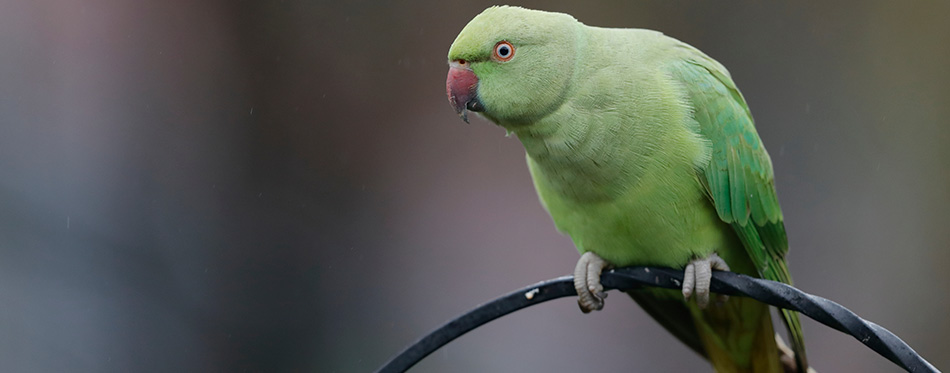
These sweet birds are extremely popular as pets and no wonder because they are easy to care for and are very friendly – they enjoy interacting with humans.
This smaller species can be a variety of colors but most have green bodies and yellow heads. Their wings are black and white and they have distinctive long tail feathers. As they are only around seven to ten inches long, they are perfect for apartment living and are one of the best birds for inexperienced owners as they are relatively low maintenance.
The barred Parakeet (also known as the Catherine Parakeet) are named after the line markings on their body. They are comical little characters and when reared correctly will happily sit on their owners, talk and whistle. Their ability to mimic sounds is pretty impressive!
It is best to keep them in pairs and they will need mentally stimulating toys to keep them amused – they’ll love a rope perch too!
Canaries
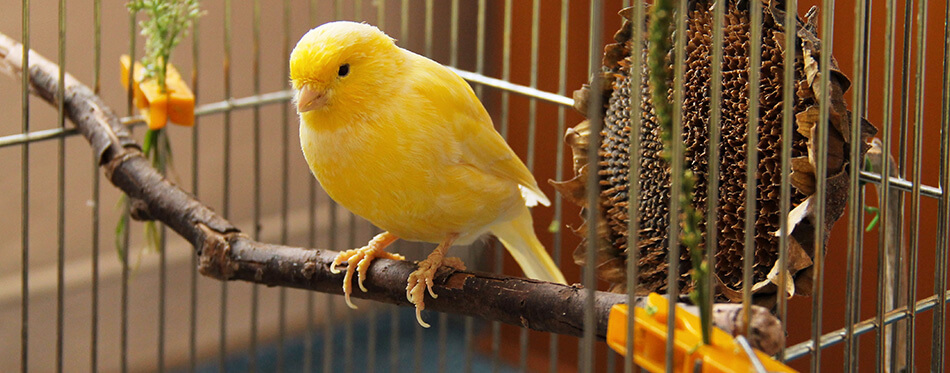
Canaries are a small and delicate bird who make great pets. They also love to sing but it is only the males who can do this. They have been one of the best pet bird choices since the 1600s and were traditionally yellow. These days they can be orange, red, black and many other colors.
Because they are easy to care for and need very little space, they are a one of the best pet birds for first time pet bird owners but you may be disappointed if you are looking for a little pal. They have a quiet nature do not form strong bonds with humans. Canaries prefer to live alone.
Finches
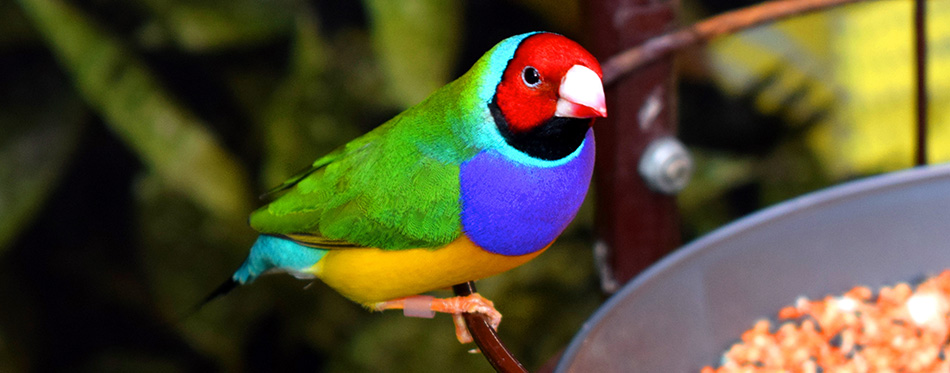
Pet finches like to live in pairs and are happiest when staying in their cage. They can be a bit shy but if you interact with them on a regular basis, they can also be very friendly. When it comes to looks, the finch is one of the most stunning bird breeds.
Different species of finch have different feathers – some are a deep green and others are iridescent blues. You will find that some have red feathers on their heads. The zebra finch owes its name to the striking black and white pattern on their upper body and wings.
Best Pet Birds for Inexperienced Bird Owners
Some types of pet birds are more suitable for inexperienced owners. These popular pet bird species will not cause their new pet parents a lot of hassle and have no complicated care requirements. As well as the parakeets, finches and canaries that you have read about above, the following birds are a good option for inexperienced bird parents.
Cockatiels
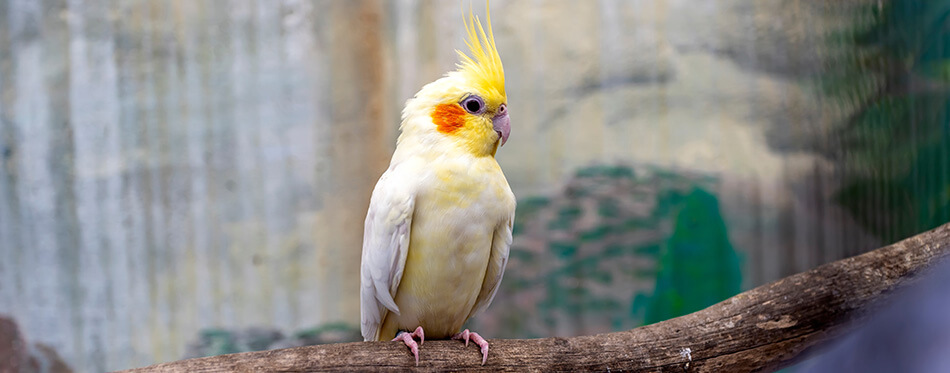
Sometimes referred to as the ‘tiels’ these charming birds are part of the cockatoo family. They are usually grey but can be several other colors. They eat mostly pellets but also need plenty of fresh vegetables.
They enjoy interacting with their human companions and do well when they are hand reared. Whilst your cockatiel is unlikely to talk to you, they will mimic household noises and give you hours of amusement.
Lovebirds
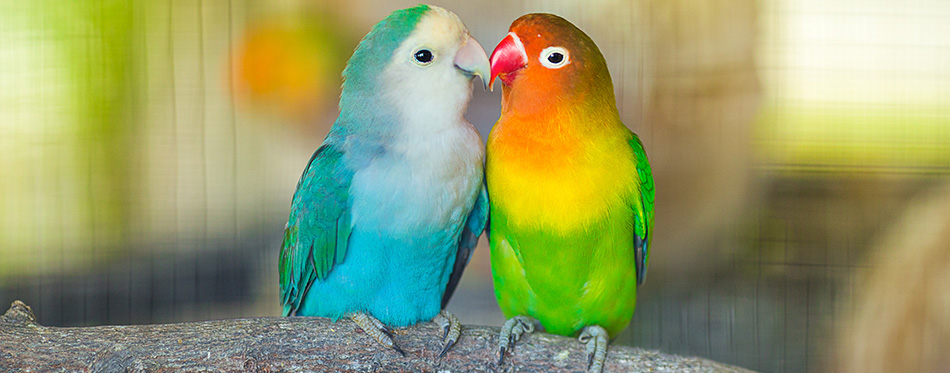
As you would expect, Lovebirds like to live in pairs. They are a member of the parrot family but are much smaller. If you get a single Lovebird, you will have to spend a lot of time keeping them amused!
This is a long term commitment as Lovebirds live for 15 to 20 years. They are very active birds who love to chirp, especially in the morning and late afternoon. They like seedbells, ladders, mirrors and anything shiny.
Parrotlets
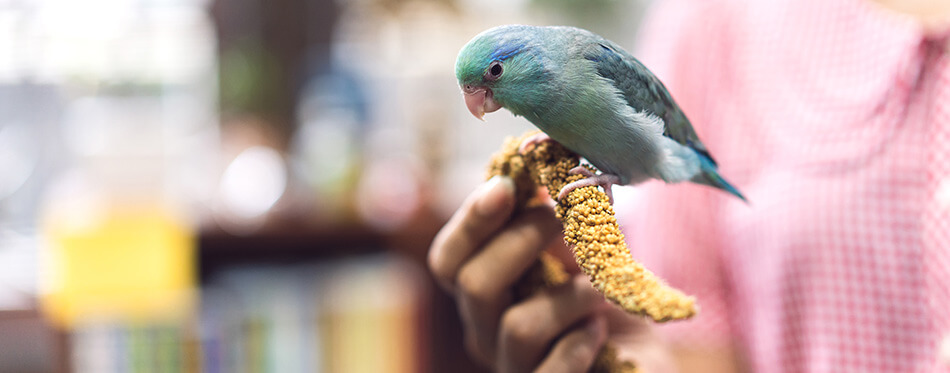
A pet Parrotlet is a tiny bird with a huge personality! They are best kept alone because in pairs one can dominate the other. Their diet should consist of 5-45% pellets and 15-25% low-fat seed mix with things like millet, barley and anise. They also need plenty of fresh vegetables and fruits.
The Pacific parrotlet is not a noisy bird but will be able to mimic some words of human speech. They are not as good at copying human voices as some other members of the parrot family.
Pet Bird Species for Larger Homes
If you have plenty of space, the parrot family and cockatoos make lovely pets.
Parrots
Parrots are probably the most famous pet bird and are widely known for their big personalities and talking ability.
The African Grey is not the largest of the family – they grow to around 13 inches. African Greys are well known as fantastic talkers! They can talk and mimic other noises. However, only experienced bird enthusiasts should take on an African Grey as they are very sensitive and quite demanding.
Pionus parrots are a medium size parrot that grow to about 10 inches in length. They are quiet and easy going compared to some of their talkative cousins. When you own a Pionus parrot you will not get a loud and talkative personality. However, if you are prepared to make the effort to interact with Pionus parrots every day, they can turn into a great companion.
Amazon parrots are very popular pets with gregarious personalities. They are very outgoing and may be a bit too boisterous for some families. The male of the species can come across as a bit ‘macho’ and strut around the place thinking that they are in charge. Their plumage is typically green and yellow and they live for over 30 years. The range of words and phrases that they can recall is quite astonishing!
The Meyer’s parrot is one of the pocket parrots as it only measures eight or nine inches in length. They will not demand attention but will benefit from regular handling. You can expect them to form a strong bond with all family members.
Finally, if you have a lot of room you may want to think about the really large parrots such as the Blue and Gold Macaw. These magnificent birds can grow up to 36 inches. As well as having a big body, these pet parrots have big personalities and need a large home where they can spend a lot of time out of their cage.
Cockatoos
Cockatoos are very well known birds and have a spectacular appearance but they require a lot of attention and can be quite high maintenance. The smallest of the miniature Cockatoos is the Goffin’s Cockatoo and even they grow to 13 inches long. Most others are much larger than this and can grow to 28 inches long.
Their talking ability is not as advanced as some of the other parrot family and they have a softer voice.
Friendliest Birds for Interaction
If you want to interact a lot with your feathered friend and make them part of the family, Cockatiels rank very highly as do the Parakeets but there are some other options. Here are some other friendly birds that you could choose from.
Doves
Doves may not be very playful birds but they have very sweet natures and are easy to domesticate. They are healthy and hardy birds who are active but not too demanding. The most popular Dove species are the Diamond doves and the Ring necked doves.
Doves love hanging around in their cage and will put up with quite a small cage as long as you let them out for a fly around every day. They prefer to live in mated pairs and you will find them cuddled up together at night.
Smaller Green Cheeked Conure
This friendly pet bird is a great communicator and is around 10 inches in length. They are easy to obtain and look after. These pretty little birds enjoy human interaction and as one of the friendliest pet bird species they are unlikely to nip you!
They will soon take the lead as the family clown and mischief maker and will keep the whole household amused. Children can handle them under close supervision.
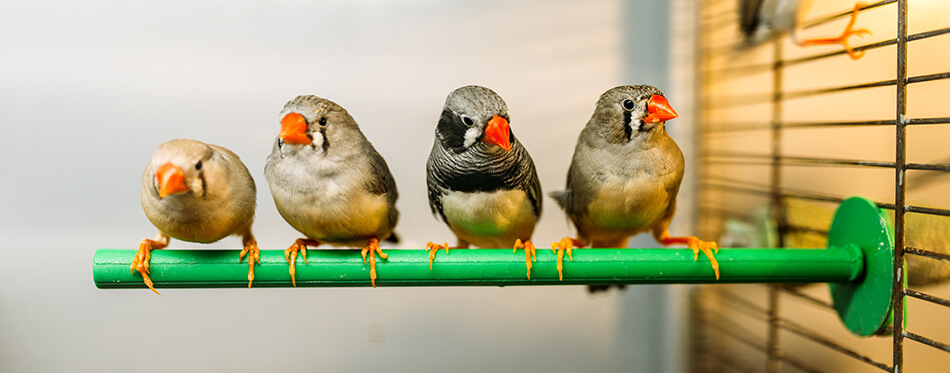
Pet Birds Dos and Don’ts
All the birds listed here are suitable as pets but you will have to put in the work to make sure that they are happy and healthy. Here is a list of some important things that you should and should not do.
Do Get the Correct Cage
When it comes to choosing the best bird cage, you need to take the size and character of your pet into account. A canary’s cage would not be suitable for a large parrot who will need a roomy cage. You also need to look at the bar spacing.
Breeders and vets will be able to give you further advice. However as an example, finches need a cage that measures 18 inches x 30 inches x 18 inches with 1/4 or 1/2 inch bar spacing. In contrast, large pet parrots like a large macaw would need a cage with dimensions 36 inches x 48 inches x 60 inches with bar spacing of 1 inch to 1.5 inches.
Do Choose the Right Food
Different bird species require different diets so do your research carefully. Most need seeds mixed with some type of fresh food. Many also enjoy soaked and cooked or sprouted legumes and raw, soaked or sprouted nuts and seeds. You may need to use supplement food pellets for some species. Cooked sweet potatoes are popular .
Don’t Feed all Types of Human Food
Some foods that humans eat are toxic to pet birds. For example, parrots cannot eat meat, chocolate or peanuts. Cheese, fish and garlic are also toxic to many birds. If your pet accidentally ingests any of these you should consult a vet right away.
Don’t Allow Children Unsupervised Access
Children usually adore pet birds thanks to their bright colors, quick movements and cheeky characters. However, very few birds are actually cuddly and many do not like being held. Even the sweetest nature bird can give a nasty nip if they are frightened or provoked. Therefore, always provide close supervision.

